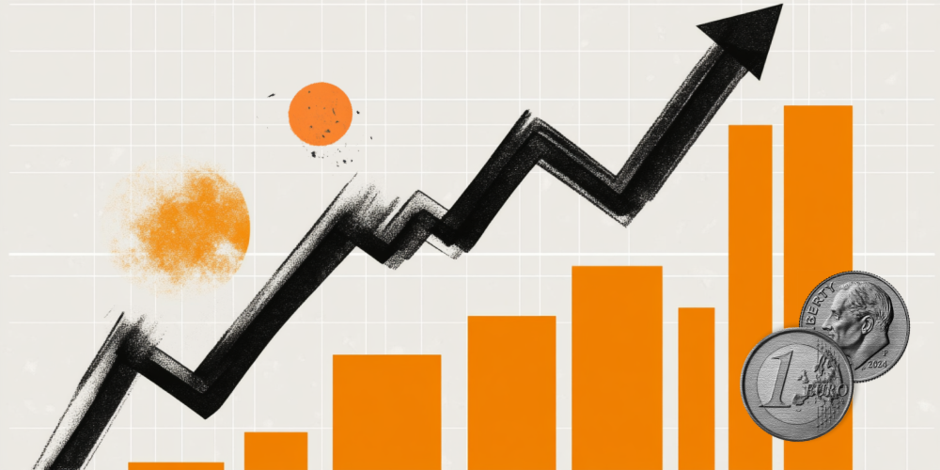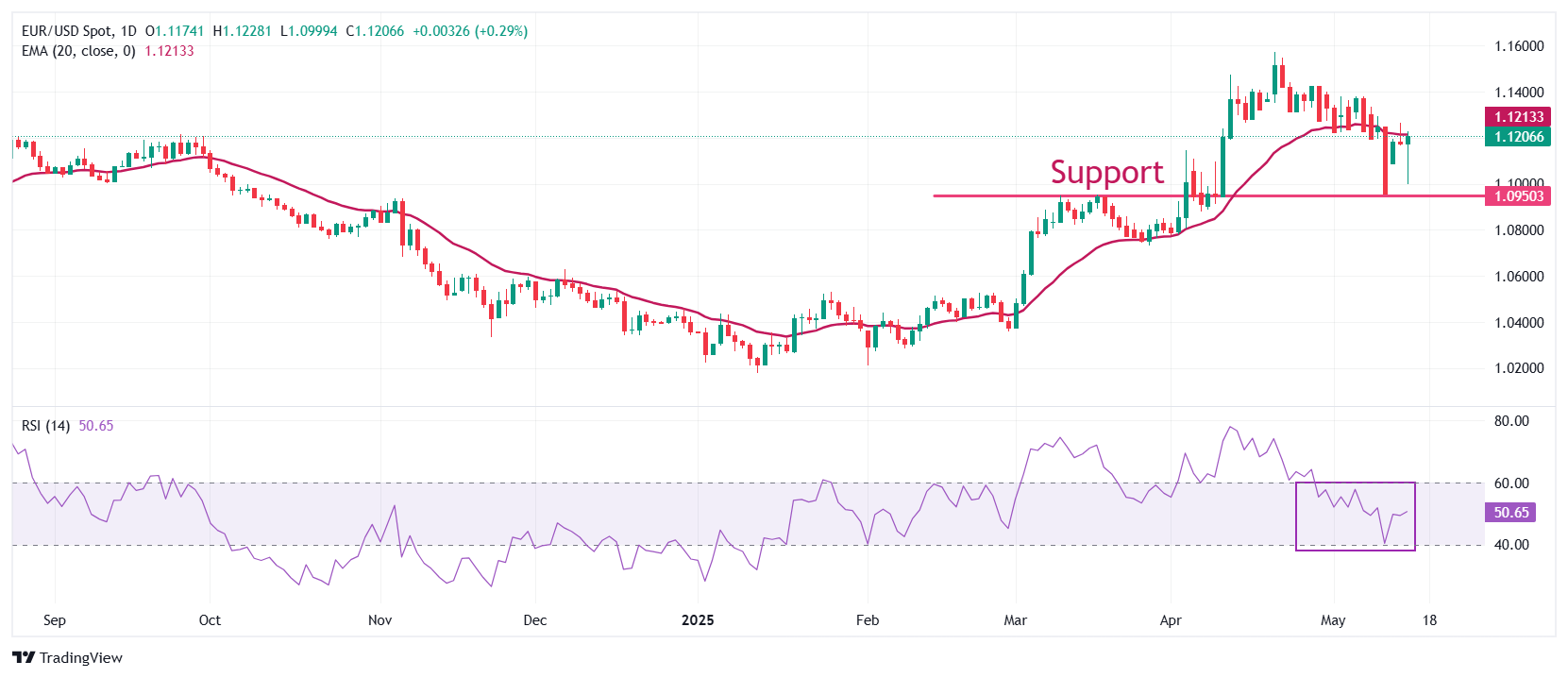Created
: 2025.05.15














![]() 2025.05.15 18:29
2025.05.15 18:29
EUR/USD gives back half of its intraday gains during European trading hours on Thursday. Still, the major currency pair is 0.2% higher, trading just above 1.1200 at the time of writing. The pair faces selling pressure as the US Dollar (USD) recoups some of its initial losses on further de-escalation in the trade war between the United States (US) and China.
The US Dollar Index (DXY), which gauges the Greenback's value against six major currencies, against six major currencies, recovers to near 100.85 from the intraday low of 100.60.
During the European trading session, US Treasury Secretary Scott Bessent stated that Washington is going into a "series of negotiations" with China to "prevent escalation" in trade tensions again. The comments from Bessent have increased investors' confidence that the world's two largest powerhouses are actively focusing on reaching a trade deal, a scenario that will lift global economic growth. "We [US] now have a mechanism with China counterparts," Bessent added.
Before comments from US Treasury Bessent, Beijing suspended non-tariff measures taken against 45 US entities, which it imposed on April 4 after the imposition of reciprocal tariffs by US President Donald Trump on April 2, Reuters reported. The decision from the Chinese Commerce Ministry came in the wake of the agreement between Washington and Beijing for a 90-day pause in the trade war, in which they lowered tariffs by 115%.
Going forward, the next major trigger for the US Dollar will be the speech from Federal Reserve (Fed) Chair Jerome Powell, and the Producer Price Index (PPI) and Retail Sales data for April in North American trading hours. Investors will pay close attention to Powell's speech to get cues about whether the central bank has changed its monetary policy stance after soft US Consumer Price Index (CPI) data for April and a temporary US-China trade truce.

EUR/USD rises above 1.1200 on Thursday. However, the near-term outlook of the pair is still uncertain as the 20-day Exponential Moving Average (EMA) is acting as a key barrier around 1.1210.
The 14-period Relative Strength Index (RSI) recovers strongly to 50.00 after sliding to near 40.00, suggesting indecisiveness among traders.
Looking up, the April 28 high of 1.1425 will be the major resistance for the pair. Conversely, the psychological level of 1.1000 will be a key support for the Euro bulls.
The Euro is the currency for the 19 European Union countries that belong to the Eurozone. It is the second most heavily traded currency in the world behind the US Dollar. In 2022, it accounted for 31% of all foreign exchange transactions, with an average daily turnover of over $2.2 trillion a day. EUR/USD is the most heavily traded currency pair in the world, accounting for an estimated 30% off all transactions, followed by EUR/JPY (4%), EUR/GBP (3%) and EUR/AUD (2%).
The European Central Bank (ECB) in Frankfurt, Germany, is the reserve bank for the Eurozone. The ECB sets interest rates and manages monetary policy. The ECB's primary mandate is to maintain price stability, which means either controlling inflation or stimulating growth. Its primary tool is the raising or lowering of interest rates. Relatively high interest rates - or the expectation of higher rates - will usually benefit the Euro and vice versa. The ECB Governing Council makes monetary policy decisions at meetings held eight times a year. Decisions are made by heads of the Eurozone national banks and six permanent members, including the President of the ECB, Christine Lagarde.
Eurozone inflation data, measured by the Harmonized Index of Consumer Prices (HICP), is an important econometric for the Euro. If inflation rises more than expected, especially if above the ECB's 2% target, it obliges the ECB to raise interest rates to bring it back under control. Relatively high interest rates compared to its counterparts will usually benefit the Euro, as it makes the region more attractive as a place for global investors to park their money.
Data releases gauge the health of the economy and can impact on the Euro. Indicators such as GDP, Manufacturing and Services PMIs, employment, and consumer sentiment surveys can all influence the direction of the single currency. A strong economy is good for the Euro. Not only does it attract more foreign investment but it may encourage the ECB to put up interest rates, which will directly strengthen the Euro. Otherwise, if economic data is weak, the Euro is likely to fall. Economic data for the four largest economies in the euro area (Germany, France, Italy and Spain) are especially significant, as they account for 75% of the Eurozone's economy.
Another significant data release for the Euro is the Trade Balance. This indicator measures the difference between what a country earns from its exports and what it spends on imports over a given period. If a country produces highly sought after exports then its currency will gain in value purely from the extra demand created from foreign buyers seeking to purchase these goods. Therefore, a positive net Trade Balance strengthens a currency and vice versa for a negative balance.
![]()
Created
: 2025.05.15
![]()
Last updated
: 2025.05.15

FXStreet is a forex information website, delivering market analysis and news articles 24/7.
It features a number of articles contributed by well-known analysts, in addition to the ones by its editorial team.
Founded in 2000 by Francesc Riverola, a Spanish economist, it has grown to become a world-renowned information website.
We hope you find this article useful. Any comments or suggestions will be greatly appreciated.
We are also looking for writers with extensive experience in forex and crypto to join us.
please contact us at [email protected].
Disclaimer:
All information and content provided on this website is provided for informational purposes only and is not intended to solicit any investment. Although all efforts are made in order to ensure that the information is correct, no guarantee is provided for the accuracy of any content on this website. Any decision made shall be the responsibility of the investor and Myforex does not take any responsibility whatsoever regarding the use of any information provided herein.
The content provided on this website belongs to Myforex and, where stated, the relevant licensors. All rights are reserved by Myforex and the relevant licensors, and no content of this website, whether in full or in part, shall be copied or displayed elsewhere without the explicit written permission of the relevant copyright holder. If you wish to use any part of the content provided on this website, please ensure that you contact Myforex.
Myforex uses cookies to improve the convenience and functionality of this website. This website may include cookies not only by us but also by third parties (advertisers, log analysts, etc.) for the purpose of tracking the activities of users. Cookie policy